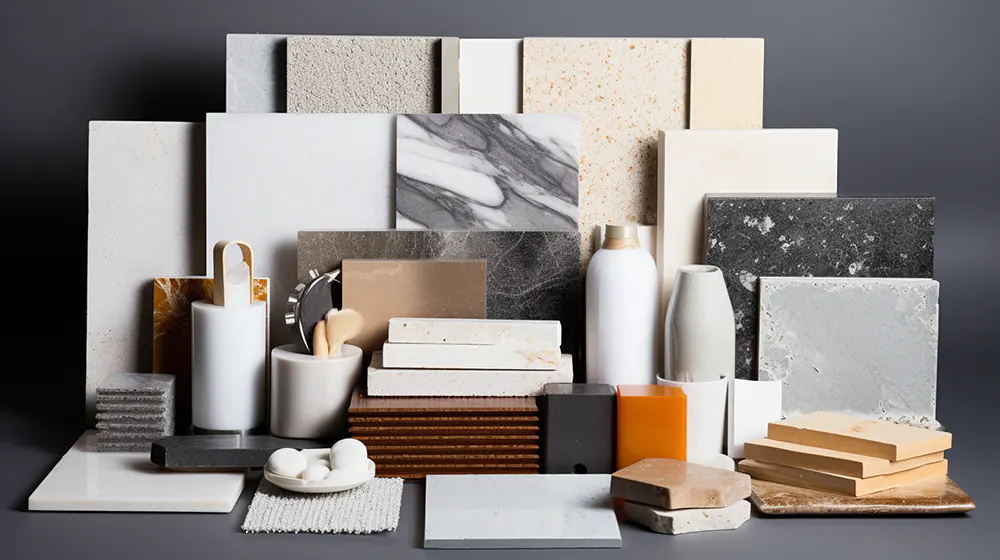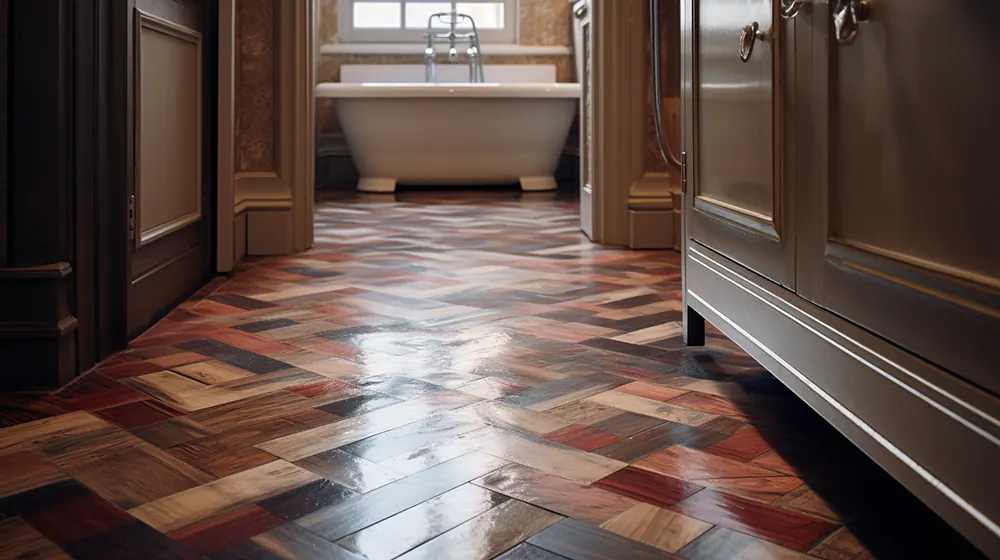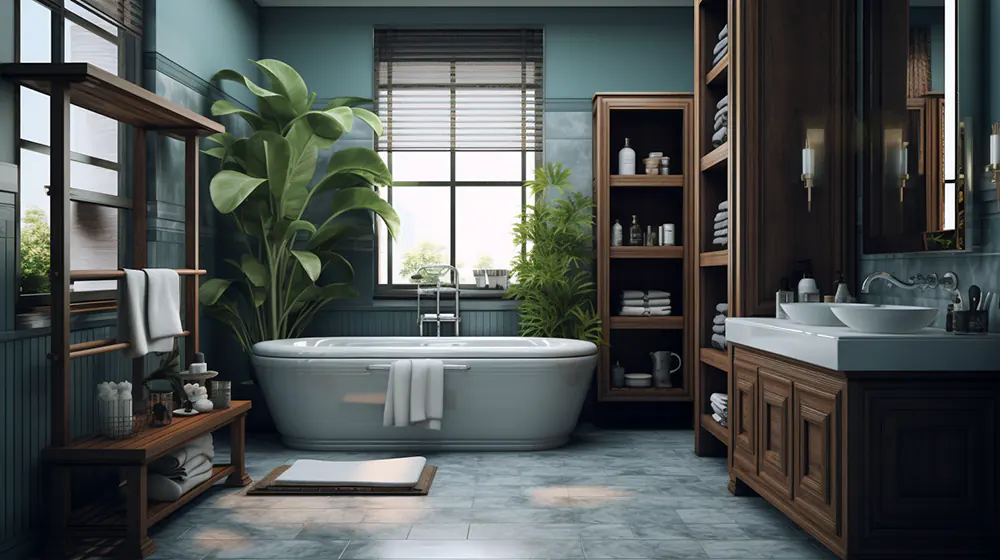
The Bathroom Remodel Checklist: Everything You Should Keep Track Of!
Introduction
A bathroom remodeling project can elevate your home’s aesthetics, increase its value, and provide a comforting personal retreat. However, the task can seem daunting without a clear plan in place.
Welcome to our definitive Bathroom Remodel Checklist! Here, we guide you step by step through the process, ensuring nothing gets overlooked in your bathroom makeover.
From selecting the right tiles to choosing the perfect fixtures and fittings, we’ve got you covered. Stay with us as we help you transform your bathroom remodel ideas into a soothing sanctuary that combines functionality with exquisite design.
Planning Phase
Before diving into any bathroom remodeling, it’s essential to have a well-thought-out plan in place. Here are some crucial factors to consider during the planning phase:
Budget

When planning your bathroom renovation, it is important to determine your budget and stick to it. Consider the following details and remember to account for any unexpected expenses:
- Research and estimate the cost of materials, fixtures, and labor.
- Prioritize your renovation needs and allocate funds accordingly.
- Consider additional expenses such as permits, design consultations, and potential structural modifications.
- Set aside a contingency budget for any unforeseen issues that may arise during the remodeling process.
- Explore cost-saving options, such as repurposing existing fixtures or opting for more affordable alternatives.
Layout and design

When planning the layout and design of your bathroom, it’s important to consider various factors. Start by assessing the size and shape of the space, as this will determine what fixtures and elements can be incorporated effectively.
Additionally, think about the placement of plumbing and electrical fixtures to ensure functionality and convenience. If necessary, consider any structural changes that may be required to optimize the space. Paying attention to these details will help you create a well-designed and functional bathroom.
Functionality

To design your new bathroom, start by deciding on the features you want. Consider if it should be a family-friendly space or a luxurious retreat. Think about your storage needs and ensure there is ample lighting. Don’t forget to include any other specific details that are important to you, such as a walk-in shower, specific shower floors, a big tub, or maybe any window treatments to add a special touch to any bathroom remodeling.
Style

When choosing a design aesthetic for your home, consider your taste and how it will harmonize with the overall look and feel of your space. You have a wide range of options to choose from, including modern and minimalistic designs that emphasize simplicity and clean lines, or more traditional and ornate styles that showcase intricate details and timeless elegance. Take into account factors such as the existing architecture, your lifestyle, and the atmosphere you want to create in each room.
Materials

When choosing materials for flooring, walls, countertops, fixtures and the shower door, it’s important to carefully consider several factors. These include durability, ease of maintenance, and cost. By taking these details into account, you can make a well-informed decision that meets your specific needs and preferences.
Design Phase

Once you have a clear vision and budget in mind, it’s time to start designing your dream bathroom. Here are some key steps to follow during the design phase:
Hiring Professionals
If the remodeling is beyond a DIY project, consider hiring professionals for a smooth and efficient renovation. This could include an architect, designer, general contractor, and plumber.
Always ensure to verify their credentials, check references, and discuss the project thoroughly before hiring. Discuss project timelines, expected costs, and any potential disruptions to your home life during the renovation.
Finalizing Design and Layout
Finalize your design and layout based on your discussions with professionals and your research. Make sure all elements you want are incorporated and that the layout is practical and suits your lifestyle. Remember, changes mid-renovation can be costly and time-consuming, so strive to finalize everything in this stage.
Ordering Supplies and Materials
Once your design is finalized, it’s time to order the supplies and materials. This includes everything from tile floor and fixtures to cabinets and lighting. Ordering in advance ensures that everything you need is available and ready when the renovation begins.
Reviewing Contracts

Before any work begins, review all contracts thoroughly, whether it is with your general contractor or designer. Make sure you understand everything, including the cost breakdown, payment schedule, and completion date. If anything is unclear, don’t hesitate to ask for clarification. Be sure to save all contracts and receipts for future reference.
The bathroom remodeling phase can finally begin once you’ve completed all the above steps. With careful planning and preparation, you can look forward to the transformation of your bathroom into a beautiful and functional space.
Construction Phase

This is where all the hard work and planning come to fruition. The construction phase includes the following steps:
Demolition
Before commencing any new construction, it is necessary to remove existing structures and fixtures. This may involve tasks such as tearing down walls, removing old tiles, or dismantling cabinets to make way for the new construction.
Structural Changes
During this stage, if you have planned any structural changes in your bathroom’s layout, such as adding windows or doors, adjusting the room’s size and shape, or installing new plumbing pipes or electrical fixtures, they will take place. It’s important to note that depending on your location, obtaining permits may also be necessary for these modifications.
Installation
Once the structural changes are complete, the next step is to begin installing new fixtures and features. This includes carefully selecting and placing tiles, flooring, cabinets, lighting, countertops, toilets, showers, and bathtubs. Paying attention to these details will ensure a functional and aesthetically pleasing result.
Finishing Touches
After all the major installations are complete, it’s time to add the finishing touches. This could include painting, adding decorative elements like mirrors and accessories, and ensuring that all fixtures are in proper working order.
Renovation Elements in a Kitchen Remodel
Bathroom remodels focus on enhancing the functionality and aesthetics of your bathroom. Here are some key elements to consider when planning a bathroom renovation:
Flooring

Choosing the right flooring and tile for your bathroom renovation is crucial for both aesthetic appeal and functionality. When it comes to flooring, materials such as ceramic, porcelain, and vinyl are popular choices due to their water-resistant properties and durability. These materials are available in a wide variety of styles and colors, allowing you to customize the look of your bathroom to your liking.
Tiles serve both a practical and decorative purpose in a bathroom. They are typically used for shower walls, floors, and sometimes even the bathroom wall itself. Similar to flooring, ceramic and porcelain are commonly used due to their durability and water resistance. Glass tiles are another option, offering a modern, sleek look and a high level of stain resistance.
In both cases, safety should be a top consideration. Opt for textured tiles or ones with a high slip-resistance rating for bathroom floors to prevent accidents. Additionally, consider the maintenance needs of your chosen materials. Some tiles may require resealing over time, so factor this into your decision.
Remember, while your bathroom needs to have a cohesive look, this doesn’t mean your flooring and tiles have to match perfectly. Contrasting colors and styles can add visual interest and depth to your space.
Shower and Bath

The shower and bathtub are typically the main features of any bathroom. When it comes to choosing these fixtures, consider the size of your bathroom and your personal preferences.
For smaller bathrooms, a combination bathtub with a built-in shower is a practical choice. If you have more space to work with, you can opt for a standalone bathtub and separate shower stall. Consider factors such as ease of use, maintenance, and accessibility when making your decision.
Sink and Bathroom Vanity

The sink and vanity are another essential aspect of any bathroom. When choosing a sink, consider the size and style that best fits your needs. Options range from pedestal sinks for a small space to large double-sinks for shared bathrooms.
In addition to functionality, the vanity also serves as a design element in your bathroom. Consider your desired aesthetic, storage space needs, and budget when selecting a vanity. You can also add decorative elements such as mirrors and lighting to enhance the overall look of your bathroom.
Toilet

While often overlooked, the toilet is a crucial element of bathroom remodeling jobs. When choosing a toilet, consider factors such as water efficiency, ease of cleaning, and comfort. Additionally, look for features such as soft-closing seats and dual-flush options for added convenience and sustainability.
Storage and Organization

A well-designed bathroom should have ample storage for all your essential items, keeping everything organized and easily accessible.
Consider utilizing vertical space by adding shelves or cabinets above the toilet or floating shelves on walls. This not only adds storage but also creates a visually appealing display.
Cabinets are another popular option for bathroom storage, providing a hidden solution for storing items like towels, toiletries, and cleaning supplies. Consider adding a combination of both open shelves and cabinets to cater to different storage needs.
To maximize storage space in a small bathroom, consider utilizing the area under the sink with built-in storage or installing wall-mounted cabinets. Another clever storage solution is using the back of the bathroom door for hanging towels and robes.
Lighting

Proper lighting can make all the difference in a bathroom, creating an inviting and functional space. Consider incorporating both natural and artificial lighting to achieve the right balance.
If your bathroom has windows, take advantage of natural light by using sheer curtains or installing frosted glass to maintain privacy while still allowing light to enter. This not only saves on energy costs but also makes the space feel more open and airy.
For artificial lighting, overhead fixtures and vanity lights are essential for tasks like applying makeup or shaving. Consider adding dimmer switches to control the level of light in your bathroom, allowing for a relaxing atmosphere during baths or nighttime routines.
Bathroom Fixtures and Hardware

From faucets and showerheads to cabinet handles and towel bars, the right fixtures and hardware can elevate the overall look of your bathroom. Consider incorporating a consistent style and finish throughout all the pieces to create a cohesive look.
Sleek, modern fixtures can add a contemporary touch, while more traditional styles can bring warmth and elegance to the space. Don’t be afraid to mix and match different finishes, such as chrome, brushed nickel, or oil-rubbed bronze, for added visual interest.
Remember to choose fixtures and hardware that not only look great but also function well. Consider factors like water flow, ease of use, and durability when making your selections.
Overall Design

When planning a bathroom renovation, it’s important to keep the overall design style in mind. The elements discussed above should all work together to create a cohesive and functional space.
Consider the color scheme, materials, and style of each aspect to ensure they complement each other. Don’t be afraid to get creative and add personal touches that reflect your unique style.
Also, think about the long-term functionality of your design choices. Will the bathroom still meet your needs in the future? Will it appeal to potential buyers if you decide to sell your home? These are important factors to consider when making design decisions.
Final Touches
As the end of your remodel approaches, it’s time to add those finishing touches that will truly make your guest bathroom feel like home. This can include adding artwork, plants, and decorative items to bring personality and warmth into the space.
Consider incorporating natural elements like a vase of fresh flowers or a small potted plant for a pop of color and life. Hang pieces of art that speak to your style and add character to the room.
Adding functional yet stylish items such as soap dispensers, toothbrush holders, and candles can also add a touch of luxury to your bathroom. These smaller details may seem insignificant but can make all the difference in creating a cohesive and inviting space.
Ways To Save On A Bathroom Remodel
Bathroom renovations can be expensive, but there are ways to save money without sacrificing quality. Consider these tips when planning your bathroom remodel to help manage the bathroom remodel cost:
- Stick to a budget: Set a budget and stick to it. This will help you prioritize which areas to splurge on and where you can cut costs.
- DIY projects: If you have some basic handyman skills, consider tackling small projects yourself, such as painting or installing hardware.
- Shop around: Don’t settle for the first item you see. Shop around and compare prices to find the best deals on fixtures, materials, and furniture.
- Refinish instead of replacing: Instead of completely replacing certain elements, consider refinishing them for a fresh look at a fraction of the cost.
- Keep plumbing in place: Moving plumbing fixtures can be costly, so try to keep the layout of your bathroom as is to save on labor and materials.
- Look for sales and discounts: Keep an eye out for sales and discounts at home improvement stores. You may be able to find high-quality items at a discounted price.

Frequently Asked Questions
How important is it to involve a professional plumber during a bathroom makeover?
Involving a professional plumber in your bathroom remodel is highly critical. They ensure that all plumbing work, such as installation of new pipes or modification of the existing ones, is done correctly and up to code. This not only ensures the functionality of your bathroom but also avoids potential damage or costly repairs in the future.
A professional plumber can also provide valuable advice on the optimal placement of fixtures and efficient use of water resources. Ultimately, their expertise and experience can save you time, money, and stress in the long run. So, it is highly recommended to involve a professional plumber in your bathroom remodel project.
How do I maintain the sustainability of my bathroom?
There are several ways to maintain the sustainability of your bathroom. Consider using eco-friendly materials such as low-flow faucets and dual-flush toilets to conserve water. Incorporate natural light and energy-efficient lighting options to reduce electricity usage.
Regularly check for leaks and fix them promptly, as well as properly dispose of any hazardous waste associated with cleaning products. It’s also important to regularly clean and maintain your bathroom fixtures and surfaces to prolong their lifespan and minimize the need for replacements.
By making conscious choices in the design and maintenance of your bathroom, you can help contribute to a more sustainable future. So, it is imperative to consider sustainability in your bathroom remodel project.
How long does a bathroom renovation take?
Each bathroom renovation is different and so each bathroom renovation timeline is different . For you to figure out how long your remodel will take there are a couple of things you can do. You can compare your job to other remodeling jobs, look at how much work is being done, how long that remodel took and estimate your own bathroom renovation. Or you can plan and structure your bathroom remodel to give yourself a timeline of when tasks will be completed.
What is the average bathroom remodel cost?
The cost of a full-scale bathroom remodel can vary greatly depending on the size, materials used, and level of customization. On average, homeowners can expect to spend anywhere from $6,000 to $30,000 for a complete bathroom remodel. This includes labor costs, materials, and fixtures.
However, costs can go up significantly if you have a larger or more complex bathroom, or if you choose high-end materials and fixtures. It’s important to set a budget and communicate with your contractor to ensure that the project stays within your desired cost range.
Conclusion
Bathroom remodeling can enhance your home’s functionality and aesthetic appeal. Consider factors from our bathroom remodel checklist like design, budget, and sustainability to create a beautiful and functional space that suits your style. Think about the overall theme or style you want to achieve and consider elements like color scheme, fixtures, and materials. Set a budget and prioritize expenses.
Decide whether to tackle the project yourself or hire a professional such as ourselves at homez remodel. You can reach us via phone (425) 905-7978 email paul@homezremodel.com or directly from our site contact page our team would love to help and suport you.
With these tips and considerations in mind, you can transform your bathroom into a luxurious and inviting oasis that adds value to your home and enhances your daily routine.


